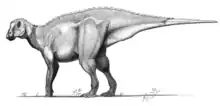Blasisaurus
Blasisaurus is a genus of lambeosaurine hadrosaurid dinosaur from the Late Cretaceous. It is known from a partial skull and skeleton found in late Maastrichtian-age rocks of Spain.[1] The type species is Blasisaurus canudoi, described in 2010 by Penélope Cruzado-Caballero, Xabier Pereda-Suberbiola and José Ignacio Ruiz-Omeñaca, a group of researchers from Spain.
| Blasisaurus | |
|---|---|
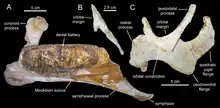 | |
| Skull fossils | |
| Scientific classification | |
| Kingdom: | Animalia |
| Phylum: | Chordata |
| Clade: | Dinosauria |
| Order: | †Ornithischia |
| Suborder: | †Ornithopoda |
| Family: | †Hadrosauridae |
| Subfamily: | †Lambeosaurinae |
| Tribe: | †Arenysaurini |
| Genus: | †Blasisaurus Cruzado-Caballero et al., 2010 |
| Type species | |
| †Blasisaurus canudoi Cruzado-Caballero et al., 2010 | |
Naming and discovery
The generic name refers to the Blasi 1 site where the fossil was found. The specific epithet honours paleontologist José Ignacio Canudo.[1] The holotype, MPZ99/667, is housed in Huesca. It was found in a layer of the Arén Formation dating from the upper Maastrichtian, about 66 million years old.[1] It consists of a skull with fragmentary lower jaws.[1]
Description
Blasisaurus is a medium-sized euornithopod. The describers have been able to identify two distinct features: the cheekbone has a rear projection with a hook-shaped upper edge, and the lower sleep window is narrow and D-shaped.[1] From the same formation is Arenysaurus, a related species. They are not identical, distinguished by the shape of the teeth and missing secondary ridges. Blasisaurus also differs from Koutalisaurus by a downwardly bent front edge of the lower jaws.[1]
Phylogeny
The describers performed an exact cladistic analysis to determine its phylogenetic position. The outcome of the phylogenetic analysis placed Blasisaurus as the sister taxon to Arenysaurus.[1] Together they form a clade that is higher in Lambeosaurinae than Tsintaosaurus and Jaxartosaurus. Whether this clade was more derived than Amurosaurus, the closest relative of the group, was not determined.[1] However, one study did find that they were not sister taxa, no other studies supported this.[2] Blasisaurus confirmed the hypothesis that in the Late Cretaceous, different Hadrosaurids from Asia and Europe was a sign that they migrated across land bridges that must have been present.[1] Where in lambeosaurinae Blasisaurus and Arenysaurus fall is disputed. They have been found to be in lambeosaurini,[3] as basal to the Lambeosaurini-Parasaurolophini split,[1] and in Parasaurolophini.[2][4] Below is the most recent cladogram published including Blasisaurus and Arenysaurus, found by Penélope Cruzado-Caballero et al. in 2013:[4]
| Hadrosauridae |
| ||||||||||||||||||||||||||||||||||||||||||||||||||||||||||||||||||||||||||||||||||||||||||||||||||||||
See also
References
- Cruzado-Caballero, Penélope; Xabier Pereda-Suberbiola; José Ignacio Ruiz-Omeñaca (2010). "Blasisaurus canudoi gen. et sp. nov., a new lambeosaurine dinosaur (Hadrosauridae) from the Latest Cretaceous of Arén (Huesca, Spain)". Canadian Journal of Earth Sciences. 47 (12): 1507–1517. doi:10.1139/E10-081.
- Cruzado-Caballero, P.; Canudo, J.I.; Moreno-Azanza, M.; Ruiz-Omeñaca, J.I. (September 22–23, 2011). "The Complex Fauna of European Maastrichtian Hadrosaurids: Contributions of the Lambeosaurines of the Iberian Peninsula" (PDF). In Braman, D.R.; Eberth, D.A; Evans, D.C.; Taylor, W. (eds.). Hadrosaur Symposium 2011 – Abstract Volume (PDF). International Hadrosaur Symposium at the Royal Tyrrell Museum of Palaeontology. Drumheller, Alberta, Canada. pp. 33–37. Archived from the original (PDF) on 2016-03-04. Retrieved 2015-04-24.
- Prieto-Márquez, A.; Dalla Vecchia, F. M.; Gaete, R.; Galobart, À. (2013). Dodson, Peter (ed.). "Diversity, Relationships, and Biogeography of the Lambeosaurine Dinosaurs from the European Archipelago, with Description of the New Aralosaurin Canardia garonnensis". PLoS ONE. 8 (7): e69835. doi:10.1371/journal.pone.0069835. PMC 3724916. PMID 23922815.
- Cruzado-Caballero, P. L.; Canudo, J. I.; Moreno-Azanza, M.; Ruiz-Omeñaca, J. I. (2013). "New material and phylogenetic position of Arenysaurus ardevoli, a lambeosaurine dinosaur from the late Maastrichtian of Arén (northern Spain)". Journal of Vertebrate Paleontology. 33 (6): 1367–1384. doi:10.1080/02724634.2013.772061.

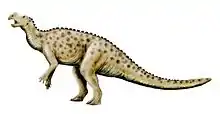

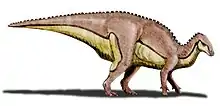
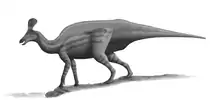
.jpg.webp)
